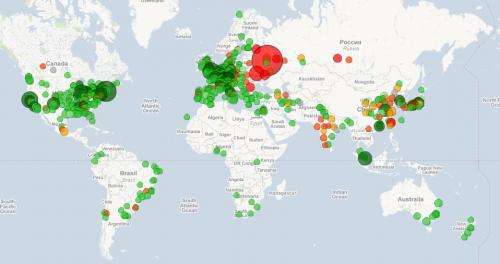March 24, 2011 report
European team suggests new way to measure scientific relevance by city

(PhysOrg.com) -- In a move that must have been at least partly aimed at provoking prideful nationalism, Lutz Bornmann of the Max Planck Society in Munich and Loet Leydesdorff from the University of Amsterdam have put together a joint project where they were able to produce what they believe is a graphical representation of the relative importance of the science being done in major cities around the world and have published it on arXiv.org.
They take the basic precept that ten percent of any scientific papers produced in any city, should account for ten percent of citations regarding those papers by others in the field and then mash it onto Google Earth maps with circles representing the relative importance of the science being done there; the bigger the circle, the more work being published; colors are used to denote performance values; red for underachievers, green for over (orange if things come out even, such as is the case with Oxford, England).
The results of their efforts can be seen online and are divided by physics, chemistry and psychology. Because it is a Google Maps/Earth application, users can zoom in and out and when they hover over a circle, the name of the city will be displayed. Also, clicking on a circle shows the statistics that were used to arrive at that circle’s size and color.
The two authors relied on data obtained from Scopus (circa 2008) for paper publication data, and used citation data up to the beginning of 2011; they focused exclusively on just three of the sciences; physics, chemistry and psychology.
Not surprisingly, their work has received some criticism due to metrics that are not so easily quantified, such as whether the language a paper is published in has any bearing on how often it’s being cited by others who prefer to cite articles who write in their native tongue. Also, the authors themselves point out in their presentation paper that their methodology doesn’t allow for actual institutions of learning to be displayed or the density of science paper writers in a city; such as where one city could for example, have a few prolific writers that get mentioned often, while other cities might have many thousands that are seldom individually mentioned.
In any case, regardless of how the project is perceived, it’s clear that another step has been taken in the ever ongoing process of measuring the quality of science that is being produced; and that can’t be a bad thing.
More information: -- Which cities produce excellent papers worldwide more than can be expected? A new mapping approach--using Google Maps--based on statistical significance testing, Lutz Bornmann, Loet Leydesdorff, arXiv:1103.3216v2 [cs.DL] arxiv.org/abs/1103.3216
© 2010 PhysOrg.com




















